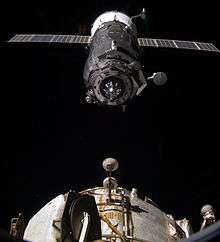Kurs (kenetlenme konumlandırma sistemi)

Kurs (Ukraynaca ve Rusça: Курс, Course, Türkçe: Seyir) Sovyet ve daha sonra Rus uzay programı tarafından kullanılan bir radyo telemetri sistemidir.
1985 öncesi[1][2] ve Kiev Radyo Fabrikası (Ukraynaca: Київський Радіозавод) tarafından üretilen Kurs, Hassas Aletler Araştırma Enstitüsü (NII TP, Rusça: НИИ Точных Приборов) tarafından geliştirilmiştir.[3]
Geçmişi
Kurs, Igla sisteminin ardılı olmuş ve bugün Soyuz uzay aracı ve Progress uzay aracı da dahil olmak üzere Rus uzay araçları için konumlandırma iletisi sağlamaktadır. Kurs, Mir uzay istasyonuna kenetlenmede tüm Rus uzay araçları için otomatik kenetlenme sistemi olmuştur.[4][5] Kenetlenme için kullanıldığında, Soyuz veya Progress uzay araçlarında çoklu antenlerden radar yayınları yapılır. Antenler arasındaki dayanımda değişkenlik sistemi, göreli konumu, durumu ve yaklaşım hızını hesaplamaya izin verir. Sistem otomatik buluşma ve kenetlenme için tasarlanmıştır, ancak bir acil durumda kozmonotlardan ya yerel olarak komut alabilir ya da Uluslararası Uzay İstasyonu'ndan kenetlenmede komut alabilir.[6]
1991 yılında Sovyetler Birliği'nin dağılmasından sonra, Kurs sistemi Ukrayna tarafında kaldı; üreticisi Rusya Federal Uzay Kurumu (RKA) ile uzaya fırlatma işinde bir rakip haline geldi. Zorlu para sorunları nedeniyle, Kiev Kurs sisteminin fiyatını yükseltti. Sonuç olarak, RKA kendi araçlarında kullanımını durdurmaya karar verdi.[7]
Kurs-NA
Kurs-NA (Rusça: Новая Активная, New Active) sadece bir buluşmada anten gerektiren kenetlenme sistemidir, gerekli Kurs-A'nın yerini almaktadır ve daha az güç kullanır.[8] Temmuz 2012'de[8] Progress M-15M ve Kasım 2013'te[9] Progress M-21M ile test edilmiştir.
UUİ
ATV
Kurs sistemi, Rus yapımı anten bölümü de dahil Avrupa Otomatikleştirilmiş Aktarım Aracı (ATV - Automated Transfer Vehicle) için bağımsız ve gereksiz kenetlenme izleme sistemi olarak görev yapmıştır.[10] Bu ek bir izleme sistemi olarak görev yapmış ve herhangi bir şekilde ATV'ye yaklaşma ya da kenetlenmesini kontrol etmek için kullanılmamıştır.
Arızaları
15 Aralık 2015'te Uluslararası Uzay İstasyonu ile Soyuz TMA-19M'in kenetlenmesi sırasında Kurs sistemi uzayda yanlış hizalanma ve Soyuz Komutanı Yuri Malenchenko tarafından el ile kenetlenme gerektiren bir durumda sabitlemede başarısız olmuştur. Bu kenetlenmeyi 10 dakika ertelemiştir.[11]
Ayrıca bakınız
- TriDAR, UUİ'de üç Uzay Mekiği uçuşlarında kullanılan bir göreli konumlandırma görüş sistemi
Kaynaklar
- ↑ NII TP history (in Russian)
- ↑ "History". Research Institute of Precision Instruments (NII TP). 24 Nisan 2008 tarihinde kaynağından arşivlendi. http://web.archive.org/web/20080424051917/http://www.niitp.ru:80/en/directions/02/history/. Erişim tarihi: 12 Ekim 2008. "The first automated docking of “Mir” orbital station with “Soyuz-TM-1” spacecraft was implemented on May 23, 1986 by means of the “Kurs” equipment. [..] "Kurs-ММ" docking system for short-range spacecraft has been designed for the upgraded spacecraft under the ISS program [..] “Kurs-M” radio-electronic system for “Kurs-ATV”, for monitoring of rendezvous and docking ATV- spacecraft (European Space Agency) with the ISS on range and radial velocity"
- ↑ "The First Serially Produced Onboard Computer". The European Virtual Computer Museum. The History of Development of Computer Science and Technologies in Ukraine. 5 Şubat 2012 tarihinde kaynağından arşivlendi. http://web.archive.org/web/20120205051120/http://www.icfcst.kiev.ua/museum/KRZ.html. Erişim tarihi: 12 Ekim 2008. "The production association Kiev Radio Factory aimed its further development toward the production of equipment for space exploration. In 1966 it started the production of a unique onboard complex named Igla for search, mutual orientation, approach and docking of space vehicles. [..] In 1985 the Igla was succeeded by the Kurs, a more advanced and reliable system, which is working now on the Mir-Soyuz-Progress complex."
- ↑ Burrough, Bryan (1998). Dragonfly: NASA and the Crisis Aboard Mir. Fourth Estate. s. 65. ISBN 0-06-093269-4. "Since 1985 all Russian spacecraft had used the Kurs computers to dock automatically with the Mir station [..] All the Russian commanders had to do was sit by and watch."
- ↑ National Space Agency of Ukraine / Kurs Research and Production Complex, Public Company
- ↑ Hinman, Elaine M; Bushman, David M. (1991). Executive Summary. "Soviet automated rendezvous and docking system overview". NASA Automated Rendezvous and Capture Review.: 34–35. Bibcode 1991arcr.nasa...34H. "IGLA system was replaced with the current KURS system. Both systems are radar-based. [..] the docking process can be controlled either from the ground or from the active (docking) spacecraft's onboard computer. [..] Soyuz TM and Progress M Series spacecraft incorporated the KURS. The MIR Complex has both systems installed."
- ↑ Linenger, Jerry (1 Ocak 2001). Off the Planet: Surviving Five Perilous Months Aboard the Space Station Mir. New York, ABD: McGraw-Hill. ISBN 978-0-07-137230-5. http://www.amazon.co.uk/Off-Planet-Surviving-Perilous-Station/dp/007137230X/ref=sr_1_1/202-3649698-1866219?ie=UTF8&s=books&qid=1174383967&sr=8-1.
- 1 2 Harding, Pete (28 Temmuz 2012). "Progress M-15M re-docks to ISS following resolution of Kurs-NA failure". NASASpaceFlight (not associated with NASA). 17 Ağustos 2016 tarihinde kaynağından arşivlendi. http://web.archive.org/web/20160817161359/https://www.nasaspaceflight.com/2012/07/progress-m-15m-re-docks-iss-kurs-na/. Erişim tarihi: 1 Eylül 2012.
- ↑ Космический грузовик «Прогресс М-21М» испытал систему сближения с МКС
- ↑ Integrated cargo carrier Figure 2-3: External Equipment on the EPM Front Cone
- ↑ "Tim Peake begins stay on international space station". http://www.bbc.co.uk/news/science-environment-35101643.